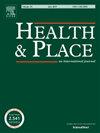洛杉矶性少数群体男性生活方式模式及医疗保健相关活动空间
IF 4.1
2区 医学
Q1 PUBLIC, ENVIRONMENTAL & OCCUPATIONAL HEALTH
引用次数: 0
摘要
对于男同性恋、双性恋和其他性少数男性(SMM)来说,居住和非居住场所的地理社会暴露对于健康来说是重要的考虑因素,因为家庭、社会、性、物质使用和医疗保健相关地点可能不同。我们使用来自洛杉矶县219名黑人和西班牙裔SMM样本的调查数据来检查个人访问的八种特定活动的地点,这些活动被分类为生活方式或医疗保健相关。空间聚类技术用于识别热点,或每个活动在空间中聚集的个人活动的地方。然后,我们根据在热点内从事活动的个人的社会人口特征,使用描述性统计来描述每个热点,然后评估基于活动的热点是否在空间上重叠。我们发现热点的独特空间模式,不同于活动。此外,生活方式活动空间热点具有社会人口特征的空间格局,主要是种族和族裔类别,而与医疗保健相关的热点则没有。热点的重叠或空间一致性高于我们的假设,因为居住地点的热点包含了大多数性热点和物质使用热点。我们的工作最终确定了洛杉矶县四个不同的地区,这些地区的活动集中在样本中的男性中,健康干预措施可以根据个人和他们在这些地方的活动量身定制。我们的研究结果表明,在精细的空间尺度上,以地理和人口为目标的干预措施对于促进SMM之间的健康至关重要,因为提供公平护理以减少SMM之间健康的种族差异的干预措施和政策是迫切需要的。本文章由计算机程序翻译,如有差异,请以英文原文为准。
Patterns of sexual minority men's lifestyle and healthcare related activity spaces in Los Angeles
For gay, bisexual, and other sexual minority men (SMM), geo-social exposures in residential and non-residential places are important to consider for health, as home, social, sexual, substance use, and healthcare-related locations may be different. We use survey data from a sample of 219 Black and Hispanic SMM within Los Angeles County to examine the places that individuals visit for eight specific activities, categorized as either lifestyle or healthcare-related. Spatial clustering techniques are used to identify hotspots, or places where individual's activities are clustered in space, for each activity. We then use descriptive statistics to characterize each hotspot based on the socio-demographic characteristics of individuals who engaged in activities within the hotspot, and then assess whether activity-based hotspots overlap in space. We find unique spatial patterns of hotspots, distinct by activity. Additionally, lifestyle activity space hotspots are spatially patterned by socio-demographic characteristics, primarily along race and ethnic categories, whereas healthcare-related hotspots are not. The overlap, or spatial congruence of hotspots, is higher than we hypothesized, as hotspots of residential locations contained the majority of sex hotspots and substance use hotspots. Our work ultimately identifies four distinct areas of Los Angeles County in which activities are clustered among men in the sample, and health interventions can be tailored to the individuals and their activities in those places. Our findings demonstrate the importance of geographically and demographically targeted interventions, at a fine spatial scale, for health promotion among SMM, as interventions and policy to provide equitable care to reduce racial disparities in health among SMM are sorely needed.
求助全文
通过发布文献求助,成功后即可免费获取论文全文。
去求助
来源期刊

Health & Place
PUBLIC, ENVIRONMENTAL & OCCUPATIONAL HEALTH-
CiteScore
7.70
自引率
6.20%
发文量
176
审稿时长
29 days
期刊介绍:
he journal is an interdisciplinary journal dedicated to the study of all aspects of health and health care in which place or location matters.
 求助内容:
求助内容: 应助结果提醒方式:
应助结果提醒方式:


